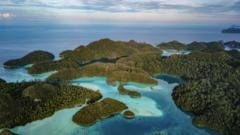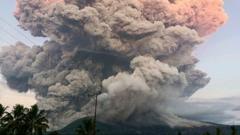The Raja Ampat archipelago faces ecological degradation due to increased nickel mining for electric vehicles, prompting government actions and community outrage.
**Mining for Electric Vehicles Threatens Biodiversity in Raja Ampat**

**Mining for Electric Vehicles Threatens Biodiversity in Raja Ampat**
Environmental activists raise concerns over nickel mining in Indonesia's marine paradise.
The Raja Ampat archipelago, often called the "Amazon of the Seas," is under threat from intensified nickel mining that supports electric vehicle (EV) production. Recent drone footage shared by Global Witness illustrates the dramatic destruction of forests and pollution of crucial marine habitats. These islands, celebrated for their astounding biodiversity and coral reefs, are witnessing a surge in mining activities, alarming conservationists and local communities alike.
In a notable turn, the Indonesian government has revoked permits for four of the five mining companies operating in the area this week, a decision applauded by environmentalists. The Ministry for the Environment emphasized that Raja Ampat's rich biodiversity must be safeguarded, noting, "We pay great attention to mining activities that occur in the area." However, photographs from Global Witness reveal extensive environmental damage, including significant loss of forest and sediment runoff that threatens fragile marine ecosystems.
The urgency of the crisis is underscored by a 500-hectare increase in land used for mining from 2020 to 2024, a change that equates to approximately 700 football fields. This growth not only damages coral reef habitats but also alters local water quality. Despite the government's recent decisions, environmental groups like Greenpeace worry that legal challenges from mining corporations could undo these protective measures. One mining company, with particularly lucrative nickel deposits, remains operational despite the government's calls for ecological restoration.
Experts like Dr. Mark Erdmann, a coral reef conservationist, express hope yet caution regarding the government's actions. He highlighted the increasing voice of local communities urging government intervention as a key factor in this decision-making process. Nevertheless, this mining tension underscores a broader dilemma: the urgent demand for critical minerals necessary for transitioning to renewable energy sources comes at a significant ecological cost.
In recent years, Indonesia has emerged as a leading producer of nickel, accounting for over half of global production, and this trend raises concerns about sustainability. Research conducted by Forest Watch Indonesia in 2024 suggests that mining correlates with increased local flooding and landslides due to deforestation, showing the wider ramifications of extractive activities.
As global calls for electric vehicles grow louder, balancing economic aspirations against environmental integrity remains a thorny issue. Dr. Michaela Guo Ying Lo’s study on sulfur mining in Sulawesi concluded that while mining may marginally alleviate local poverty, it severely compromises environmental quality, undermining the overall well-being of communities. Activist Imam Shofwan warns that while nickel mining may be framed as a solution to climate concerns, it incurs devastating local consequences, harming farming and fishing livelihoods essential for people's survival.
In a rapidly changing world, the Indonesian case exemplifies the pressing challenge of sustainable development. As this dilemma unfolds, the question looms: how much ecological damage are we willing to accept in pursuit of a greener future?
In a notable turn, the Indonesian government has revoked permits for four of the five mining companies operating in the area this week, a decision applauded by environmentalists. The Ministry for the Environment emphasized that Raja Ampat's rich biodiversity must be safeguarded, noting, "We pay great attention to mining activities that occur in the area." However, photographs from Global Witness reveal extensive environmental damage, including significant loss of forest and sediment runoff that threatens fragile marine ecosystems.
The urgency of the crisis is underscored by a 500-hectare increase in land used for mining from 2020 to 2024, a change that equates to approximately 700 football fields. This growth not only damages coral reef habitats but also alters local water quality. Despite the government's recent decisions, environmental groups like Greenpeace worry that legal challenges from mining corporations could undo these protective measures. One mining company, with particularly lucrative nickel deposits, remains operational despite the government's calls for ecological restoration.
Experts like Dr. Mark Erdmann, a coral reef conservationist, express hope yet caution regarding the government's actions. He highlighted the increasing voice of local communities urging government intervention as a key factor in this decision-making process. Nevertheless, this mining tension underscores a broader dilemma: the urgent demand for critical minerals necessary for transitioning to renewable energy sources comes at a significant ecological cost.
In recent years, Indonesia has emerged as a leading producer of nickel, accounting for over half of global production, and this trend raises concerns about sustainability. Research conducted by Forest Watch Indonesia in 2024 suggests that mining correlates with increased local flooding and landslides due to deforestation, showing the wider ramifications of extractive activities.
As global calls for electric vehicles grow louder, balancing economic aspirations against environmental integrity remains a thorny issue. Dr. Michaela Guo Ying Lo’s study on sulfur mining in Sulawesi concluded that while mining may marginally alleviate local poverty, it severely compromises environmental quality, undermining the overall well-being of communities. Activist Imam Shofwan warns that while nickel mining may be framed as a solution to climate concerns, it incurs devastating local consequences, harming farming and fishing livelihoods essential for people's survival.
In a rapidly changing world, the Indonesian case exemplifies the pressing challenge of sustainable development. As this dilemma unfolds, the question looms: how much ecological damage are we willing to accept in pursuit of a greener future?





















